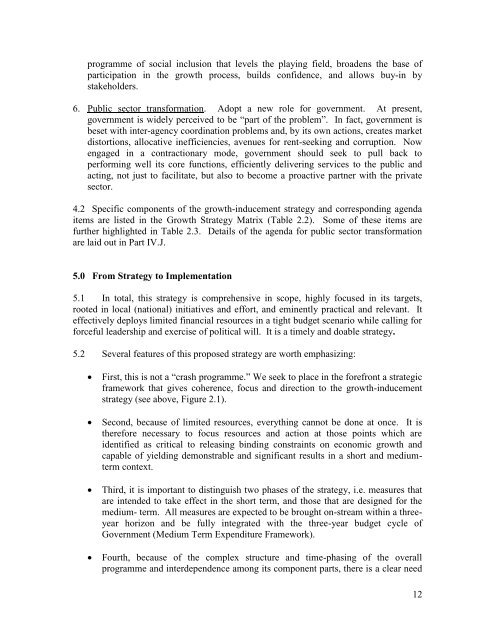PIOJ Growth-Inducement Strategy - Planning Institute of Jamaica
PIOJ Growth-Inducement Strategy - Planning Institute of Jamaica
PIOJ Growth-Inducement Strategy - Planning Institute of Jamaica
Create successful ePaper yourself
Turn your PDF publications into a flip-book with our unique Google optimized e-Paper software.
programme <strong>of</strong> social inclusion that levels the playing field, broadens the base <strong>of</strong><br />
participation in the growth process, builds confidence, and allows buy-in by<br />
stakeholders.<br />
6. Public sector transformation. Adopt a new role for government. At present,<br />
government is widely perceived to be “part <strong>of</strong> the problem”. In fact, government is<br />
beset with inter-agency coordination problems and, by its own actions, creates market<br />
distortions, allocative inefficiencies, avenues for rent-seeking and corruption. Now<br />
engaged in a contractionary mode, government should seek to pull back to<br />
performing well its core functions, efficiently delivering services to the public and<br />
acting, not just to facilitate, but also to become a proactive partner with the private<br />
sector.<br />
4.2 Specific components <strong>of</strong> the growth-inducement strategy and corresponding agenda<br />
items are listed in the <strong>Growth</strong> <strong>Strategy</strong> Matrix (Table 2.2). Some <strong>of</strong> these items are<br />
further highlighted in Table 2.3. Details <strong>of</strong> the agenda for public sector transformation<br />
are laid out in Part IV.J.<br />
5.0 From <strong>Strategy</strong> to Implementation<br />
5.1 In total, this strategy is comprehensive in scope, highly focused in its targets,<br />
rooted in local (national) initiatives and effort, and eminently practical and relevant. It<br />
effectively deploys limited financial resources in a tight budget scenario while calling for<br />
forceful leadership and exercise <strong>of</strong> political will. It is a timely and doable strategy.<br />
5.2 Several features <strong>of</strong> this proposed strategy are worth emphasizing:<br />
<br />
<br />
<br />
<br />
First, this is not a “crash programme.” We seek to place in the forefront a strategic<br />
framework that gives coherence, focus and direction to the growth-inducement<br />
strategy (see above, Figure 2.1).<br />
Second, because <strong>of</strong> limited resources, everything cannot be done at once. It is<br />
therefore necessary to focus resources and action at those points which are<br />
identified as critical to releasing binding constraints on economic growth and<br />
capable <strong>of</strong> yielding demonstrable and significant results in a short and mediumterm<br />
context.<br />
Third, it is important to distinguish two phases <strong>of</strong> the strategy, i.e. measures that<br />
are intended to take effect in the short term, and those that are designed for the<br />
medium- term. All measures are expected to be brought on-stream within a threeyear<br />
horizon and be fully integrated with the three-year budget cycle <strong>of</strong><br />
Government (Medium Term Expenditure Framework).<br />
Fourth, because <strong>of</strong> the complex structure and time-phasing <strong>of</strong> the overall<br />
programme and interdependence among its component parts, there is a clear need<br />
12
















